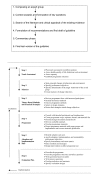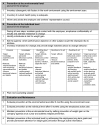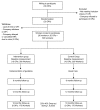Design of the Balance@Work project: systematic development, evaluation and implementation of an occupational health guideline aimed at the prevention of weight gain among employees
- PMID: 20003405
- PMCID: PMC2799413
- DOI: 10.1186/1471-2458-9-461
Design of the Balance@Work project: systematic development, evaluation and implementation of an occupational health guideline aimed at the prevention of weight gain among employees
Abstract
Background: Occupational health professionals may play an important role in preventive health promotion activities for employees. However, due to a lack of knowledge and evidence- and practice based methods and strategies, interventions are hardly being implemented by occupational physicians to date. The aim of the Balance@Work project is to develop, evaluate, and implement an occupational health guideline aimed at the prevention of weight gain among employees.
Methods: Following the guideline development protocol of the Netherlands Society of Occupational Medicine and the Intervention Mapping protocol, the guideline was developed based on literature, interviews with relevant stakeholders, and consensus among an expert group. The guideline consists of an individual and an environmental component. The individual component includes recommendations for occupational physicians on how to promote physical activity and healthy dietary behavior based on principles of motivational interviewing. The environmental component contains an obesogenic environment assessment tool. The guideline is evaluated in a randomised controlled trial among 20 occupational physicians. Occupational physicians in the intervention group apply the guideline to eligible workers during 6 months. Occupational physicians in the control group provide care as usual. Measurements take place at baseline and 6, 12, and 18 months thereafter. Primary outcome measures include waist circumference, daily physical activity and dietary behavior. Secondary outcome measures include sedentary behavior, determinants of behavior change, body weight and body mass index, cardiovascular disease risk profile, and quality of life. Additionally, productivity, absenteeism, and cost-effectiveness are assessed.
Discussion: Improving workers' daily physical activity and dietary behavior may prevent weight gain and subsequently improve workers' health, increase productivity, and reduce absenteeism. After an effect- and process evaluation the guideline will be adjusted and, after authorisation, published. Together with several implementation aids, the published guideline will be disseminated broadly by the Netherlands Society of Occupational Medicine.
Trial registration: ISRCTN73545254/NTR1190.
Figures




Similar articles
-
The application of an occupational health guideline reduces sedentary behaviour and increases fruit intake at work: results from an RCT.Occup Environ Med. 2012 Jul;69(7):500-7. doi: 10.1136/oemed-2011-100377. Epub 2012 Mar 1. Occup Environ Med. 2012. PMID: 22383591 Clinical Trial.
-
Economic evaluation of an occupational health care guideline for prevention of weight gain among employees.J Occup Environ Med. 2013 Sep;55(9):1100-9. doi: 10.1097/JOM.0b013e31829b279a. J Occup Environ Med. 2013. PMID: 23969508 Clinical Trial.
-
Long-term effects of an occupational health guideline on employees' body weight-related outcomes, cardiovascular disease risk factors, and quality of life: results from a randomized controlled trial.Scand J Work Environ Health. 2013 May 1;39(3):284-94. doi: 10.5271/sjweh.3341. Epub 2013 Jan 3. Scand J Work Environ Health. 2013. PMID: 23288297 Clinical Trial.
-
The NHF-NRG In Balance-project: the application of Intervention Mapping in the development, implementation and evaluation of weight gain prevention at the worksite.Obes Rev. 2007 Jul;8(4):347-61. doi: 10.1111/j.1467-789X.2006.00304.x. Obes Rev. 2007. PMID: 17578384 Review.
-
The effectiveness of workplace nutrition and physical activity interventions in improving productivity, work performance and workability: a systematic review.BMC Public Health. 2019 Dec 12;19(1):1676. doi: 10.1186/s12889-019-8033-1. BMC Public Health. 2019. PMID: 31830955 Free PMC article.
Cited by
-
The effectiveness of workplace dietary interventions: protocol for a systematic review and meta-analysis.Syst Rev. 2016 Feb 3;5:20. doi: 10.1186/s13643-016-0200-1. Syst Rev. 2016. PMID: 26842069 Free PMC article.
-
Workplace interventions for reducing sitting at work.Cochrane Database Syst Rev. 2018 Jun 20;6(6):CD010912. doi: 10.1002/14651858.CD010912.pub4. Cochrane Database Syst Rev. 2018. Update in: Cochrane Database Syst Rev. 2018 Dec 17;12:CD010912. doi: 10.1002/14651858.CD010912.pub5. PMID: 29926475 Free PMC article. Updated.
-
Exploring the dynamics of a free fruit at work intervention.BMC Public Health. 2016 Aug 19;16(1):839. doi: 10.1186/s12889-016-3500-4. BMC Public Health. 2016. PMID: 27542384 Free PMC article. Clinical Trial.
-
Workplace interventions for reducing sitting at work.Cochrane Database Syst Rev. 2018 Dec 17;12(12):CD010912. doi: 10.1002/14651858.CD010912.pub5. Cochrane Database Syst Rev. 2018. PMID: 30556590 Free PMC article.
-
Using intervention mapping to develop and adapt a secondary stroke prevention program in Veterans Health Administration medical centers.Implement Sci. 2010 Dec 15;5:97. doi: 10.1186/1748-5908-5-97. Implement Sci. 2010. PMID: 21159171 Free PMC article.
References
-
- Diet, nutrition and the prevention of chronic diseases. World Health Organ Tech Rep Ser. 2003;916:i–149. backcover. - PubMed
-
- Proper KI, Hildebrandt VH. Overweight and obesity among Dutch workers: differences between occupational groups and sectors. Int Arch Occup Environ Health. 2009. Epub ahead of print. - PubMed
-
- Nooyens AC, Visscher TL, Verschuren WM, Schuit AJ, Boshuizen HC, van Mechelen W. Age, period and cohort effects on body weight and body mass index in adults: The Doetinchem Cohort Study. Public Health Nutr. 2008. pp. 1–9. - PubMed
Publication types
MeSH terms
Associated data
LinkOut - more resources
Full Text Sources

